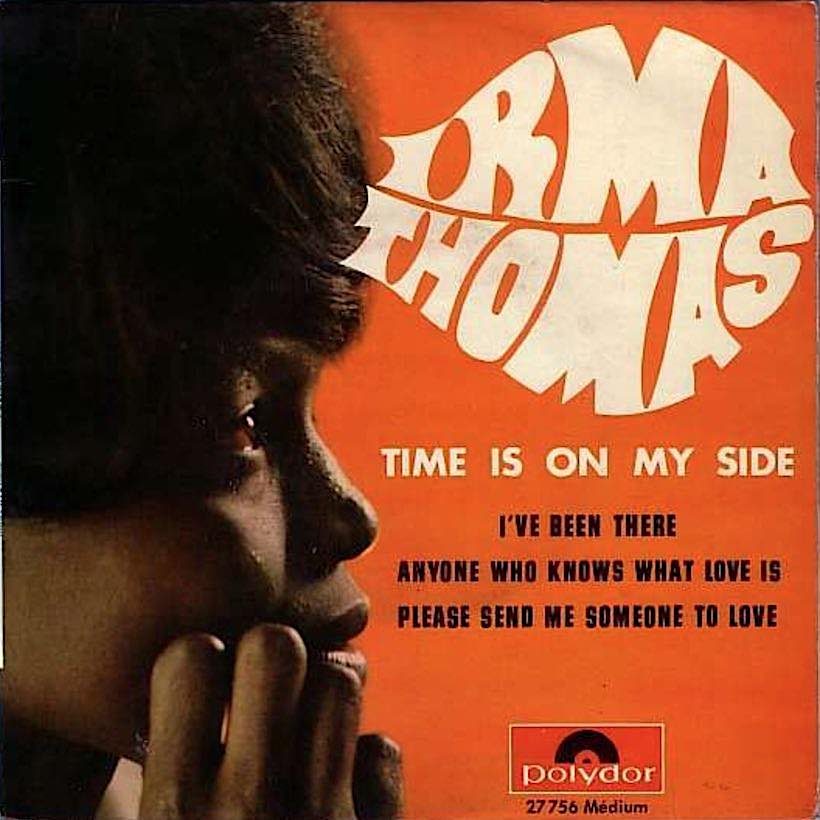‘Time Is On My Side’: Irma Thomas, The Rolling Stones And An Ageless Hit
uDiscover Music looks at the history of the 1960s composition by Jerry Ragovoy that continues to reverberate in pop culture.

Time is always on the side of a great song, both in terms of regular remakes and the continuing profile of a classic version. Another reminder comes in the appearance of the Soul Queen of New Orleans, Irma Thomas, in the soundtrack of HBO’s autumn 2019 superhero drama series Watchmen. The song in question couldn’t be better named: it’s her 1964 recording that immediately inspired the Rolling Stones to record the cover that became their first US top ten hit, ‘Time Is On My Side.’
The series, based on the DC Comics series of the same name, premiered on 20 October 2019 and features numerous classic discs. Dinah Washington‘s take on ‘Unforgettable’ is in episode 1, while the Temptations’ ‘Ball Of Confusion’ and Eartha Kitt’s ‘Santa Baby’ are part of episode 2 along with the Beastie Boys‘ ‘Egg Man.’ Also featured throughout the series is the accompanying score by Trent Reznor and Atticus Ross of Nine Inch Nails.
The third part of Watchmen has everything from Devo’s ‘Mongoloid’ to Desmond Dekker and the Aces’ ‘Israelites,’ as well as Gene Autry’s ‘The Last Round Up.’ In a similarly mixed bag, part four highlights, among others, Dolly Parton and Kenny Rogers’ ‘Islands In The Stream,’ Billie Holiday’s ‘You’re My Thrill’ and Leroy Sibbles’ Studio One reggae gem ‘Do Your Thing.’ Thomas’ mighty recording of ‘Time Is On My Side’ stands tall among them.
Not every listener who knows the song will realise that neither Irma’s interpretation, nor the Stones’, was the original — although Thomas’ was the first with all the words we’ve come to know. The song was written (under the pseudonym Norman Meade) by the great Philadelphia-born writer-producer Jerry Ragovoy, whose stellar career you can read about in this dedicated uDiscover Music story. Perhaps improbably, the first ‘Time Is On My Side’ was cut a short time earlier by a jazz trombonist. This was Danish-American Kai Winding, during his association with Verve Records, when the rather different prototype was produced by studio notable Creed Taylor and engineered by Phil Ramone.
It was released as a Verve single on 3 October 1963 and had clearly discernible backing vocals by Dionne Warwick, along with her sister Dee Dee and their aunt Cissy Houston, mother of Whitney. Winding’s recording came out a matter of weeks before Dionne released the single that became her first US top ten hit, ‘Anyone Who Had A Heart.’ This early version was a template for those that we came to know, containing only the title phrase and the equally memorable “You’ll come running back to me,” with Winding’s trumpet taking the rest of the lead.
Down in New Orleans, Irma Thomas, her label Imperial and producer Eddie Ray heard potential in the track, but knew it needed work. Nashville native, artist and songwriter Jimmy Norman came on board to flesh out the lyrics (“You’re searching for good times, but just wait and see…” and so on) and Irma cut it — but only as the b-side of her June 1964 single ‘Anyone Who Knows What Love Is (Will Understand).’ The haunting top side, which reached No. 29 R&B in the US and No. 52 pop, got small-screen attention of its own in the earlier 2000s, thanks to its repeated inclusion in British writer Charlie Brooker’s sci-fi anthology series Black Mirror.
The Stones were soon recording ‘Time Is On My Side’ not once, but twice. The version that has more regularly appeared on their compilations in later years is the one recorded in Chicago in November 1964 and released on their sophomore UK studio LP The Rolling Stones No. 2, on 15 January 1965.
But they had earlier cut a looser-feeling arrangement, with organ in the intro rather than guitar, in London the previous June. Both 1960s versions feature on the box set The Rolling Stones In Mono. The earlier recording, with an organ intro rather than the guitar motif, became a US single on 25 September. It was included on the Stones’ second American album 12 x 5, which followed on 17 October. That 45 climbed to No. 6 on the Billboard Hot 100, easily their best showing to date, and reached No. 4 in Australia, but was never a UK single; the song did have that distinction, but not until 1982’s live take from the Still Life album.
Scores of covers of ‘Time Is On My Side’ began to accrue almost immediately, but those from the 1965-66 season are especially fascinating. Early in 1965, the Moody Blues did it as the b-side of their follow-up to the UK chart-topper ‘Go Now’; the same year brought covers by Brian Poole and the Tremeloes, Paul Revere and the Raiders and even George Martin, in a splendidly-orchestrated instrumental from his George Martin Scores Instrumental Versions of the Hits LP.
As if to strike back for the Rolling Stones team, their co-manager Andrew Loog Oldham soon did the same in the guise of the Andrew Oldham Orchestra, in a deliberately schlocky MOR remake on the June 1966 album The Rolling Stones Songbook. Wilson Pickett put ‘Time’ on his The Wicked Pickett set in October that year.
A generation later, Keith Richards would revisit the song again by including it in the live set captured on the Live at the Hollywood Palladium, December 15, 1988 album, with lead vocals by LaBelle’s Sarah Dash. Of many subsequent readings, special mention goes to “Possum” himself, George Jones, who visited this fertile watering ground on the 1997 album Stone Country — Country Artists Perform the Songs of the Rolling Stones.
Trent Reznor and Atticus Ross’ Watchmen soundtrack can be bought here.












